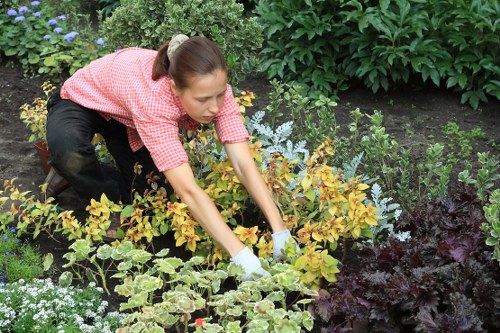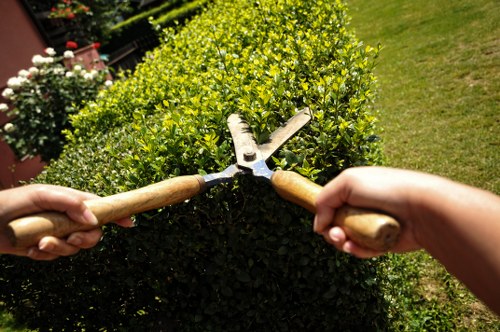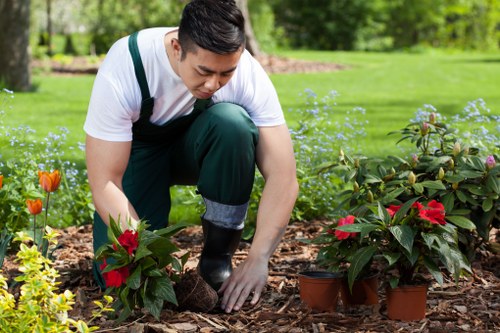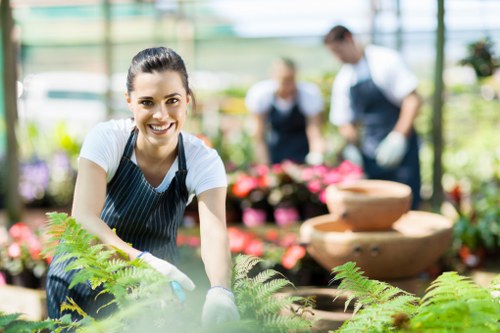Gardener Burnt Oak

Gardening in Burnt Oak offers a unique blend of challenges and rewards. Nestled in the heart of London, Burnt Oak is known for its vibrant community and diverse range of plants that thrive in its specific climate conditions. Whether you're a seasoned gardener or just starting out, understanding the nuances of gardening in Burnt Oak can significantly enhance your gardening experience.
The local climate plays a crucial role in determining which plants will flourish in Burnt Oak. With its temperate weather, gardeners have the advantage of a longer growing season compared to other regions. This allows for a wider variety of plants to be cultivated, from colorful annuals to hardy perennials.
Soil quality is another important factor to consider. Burnt Oak's soil tends to be rich in organic matter, providing an excellent foundation for plant growth. However, it's essential to conduct soil tests periodically to ensure that it maintains the right pH levels and nutrient balance required for your garden's specific needs.

Choosing the Right Plants for Burnt Oak
Selecting the appropriate plants is paramount for a thriving garden in Burnt Oak. Native plants are often the best choice as they are well-adapted to the local climate and soil conditions. These plants typically require less maintenance and are more resistant to pests and diseases.
Some popular choices among Burnt Oak gardeners include lavender, which not only adds a beautiful fragrance to your garden but also attracts beneficial pollinators like bees and butterflies. Additionally, herbs such as rosemary and thyme are favored for their versatility in both culinary and ornamental uses.
Fruit trees can also prosper in Burnt Oak, provided they are given adequate space and care. Varieties like apple, pear, and cherry trees are excellent options that yield delicious produce while enhancing the aesthetic appeal of your garden.

Soil Preparation and Maintenance
Proper soil preparation is the foundation of a successful garden. In Burnt Oak, it's essential to ensure that your soil is well-draining yet retains enough moisture to support plant growth. Adding compost or well-rotted manure can significantly improve soil structure and fertility.
Mulching is another effective practice that helps retain soil moisture, suppress weeds, and regulate soil temperature. Organic mulches such as bark chips or straw are ideal choices that gradually decompose, enriching the soil over time.
Regular soil testing can help you monitor nutrient levels and make necessary amendments. This proactive approach ensures that your plants receive the essential nutrients they need to thrive throughout the growing season.

Watering Techniques for Efficient Gardening
Efficient watering is critical for maintaining a healthy garden in Burnt Oak. Overwatering can lead to root rot and other fungal diseases, while underwatering can stress plants and reduce their productivity. Striking the right balance is key.
Drip irrigation systems are highly recommended as they deliver water directly to the plant's root zone, minimizing water wastage and reducing the risk of disease. Additionally, watering early in the morning helps prevent evaporation and allows plants to absorb moisture before the heat of the day.
Incorporating rainwater harvesting can also be beneficial. Collecting and storing rainwater not only conserves water but also provides a natural and chemical-free water source for your garden.

Pest and Disease Management
Managing pests and diseases is an ongoing challenge for gardeners in Burnt Oak. Adopting integrated pest management (IPM) strategies can help minimize the impact while reducing reliance on chemical pesticides.
Encouraging beneficial insects, such as ladybugs and lacewings, can naturally control pest populations. Additionally, practicing crop rotation and maintaining healthy soil can prevent the buildup of pathogens that cause plant diseases.
Regular monitoring and early detection are crucial for effective pest and disease control. Identifying issues at an early stage allows for prompt action, preventing minor problems from escalating into major setbacks.
Seasonal Gardening Tips
Understanding the seasonal changes in Burnt Oak is essential for year-round gardening success. Each season presents unique opportunities and challenges that require tailored approaches.
- Spring: Ideal for planting new annuals and perennials. Focus on soil preparation and early fertilization.
- Summer: Emphasize watering and pest control. Maintain mulch to retain moisture.
- Autumn: Prepare for the colder months by planting hardy vegetables and adding compost.
- Winter: Protect sensitive plants with coverings and plan for the next growing season.
By aligning your gardening activities with the seasons, you can ensure that your garden remains healthy and productive throughout the year.
Gardening Tools and Equipment
Having the right tools and equipment can make gardening in Burnt Oak more efficient and enjoyable. Essential tools include a sturdy trowel, pruning shears, a watering can or hose, and a good pair of gloves to protect your hands.
Investing in quality tools can save you time and effort in the long run. Additionally, tools with ergonomic designs can reduce strain and prevent injuries, allowing you to garden comfortably for longer periods.
Proper maintenance of your gardening tools is equally important. Regular cleaning and sharpening can extend their lifespan and ensure they perform optimally when you need them most.
Local Gardening Resources in Burnt Oak
Burnt Oak boasts a range of local gardening resources that can support your gardening endeavors. From community gardens to local nurseries, these resources provide valuable information and materials tailored to the specific needs of Burnt Oak gardeners.
- Burnt Oak Community Garden: A collaborative space where gardeners can share knowledge, resources, and foster a sense of community.
- Local Nurseries: Offer a variety of native plants, gardening tools, and expert advice on plant selection and care.
- Gardening Workshops: Regularly held sessions that cover topics ranging from soil health to sustainable gardening practices.
- Online Forums: Virtual platforms where Burnt Oak gardeners can exchange tips, seek advice, and showcase their gardens.
- Garden Clubs: Groups that organize events, plant exchanges, and collaborative gardening projects within the Burnt Oak area.
Sustainable Gardening Practices
Embracing sustainable gardening practices not only benefits your garden but also contributes to the broader environmental health of Burnt Oak. Incorporating techniques such as composting, rainwater harvesting, and the use of organic fertilizers can make your garden more eco-friendly.
Composting kitchen scraps and garden waste reduces landfill contributions and provides a rich source of nutrients for your plants. Additionally, organic fertilizers enhance soil health without introducing harmful chemicals into the ecosystem.
By adopting these sustainable practices, you can create a garden that is both beautiful and environmentally responsible, aligning with the community's green initiatives.
10-15 Nearby Areas to Burnt Oak for Gardeners
- Wembley: Known for its expansive parks and community gardens, Wembley offers ample space for gardening enthusiasts.
- Kingsbury: Features well-maintained green spaces ideal for cultivating a variety of plants.
- Canons Park: Offers picturesque landscapes and gardens that serve as inspiration for local gardeners.
- Hendon: Home to several nurseries and gardening supply stores catering to diverse gardening needs.
- Colindale: Provides access to botanical gardens and educational resources for passionate gardeners.
- Mill Hill: Known for its large community gardens and sustainable gardening programs.
- Sainsbury Park: Offers beautifully landscaped areas perfect for relaxation and gardening activities.
- Edgware: Features a variety of plant shops and gardening clubs for enthusiasts to join.
- Burnham Green: A local favorite for its serene gardens and community farming initiatives.
- Golders Green: Offers a mix of residential gardens and public green spaces suitable for all gardening levels.
- Arkley: Known for its extensive parklands and gardening workshops held throughout the year.
- Temple Fortune: Provides access to beautiful private and public gardens, fostering a strong gardening community.
- Queensbury: Features botanical gardens and eco-friendly gardening resources.
- Totteridge: Renowned for its historic gardens and dedicated gardening societies.
- East Barnet: Offers diverse gardening opportunities with a mix of native and exotic plants.
These nearby areas complement Burnt Oak's gardening scene, providing additional resources, inspiration, and community support for gardeners looking to expand their horticultural horizons.
Frequently Asked Questions
1. What are the best plants for beginner gardeners in Burnt Oak?
Answer: Beginners should consider low-maintenance plants such as lavender, rosemary, and marigolds. These plants are hardy, require minimal care, and thrive well in Burnt Oak's climate.
2. How can I improve the soil quality in my Burnt Oak garden?
Answer: Adding organic compost or well-rotted manure can greatly enhance soil quality. Regular soil testing can also help you understand nutrient deficiencies and amend accordingly.
3. What are some sustainable gardening practices suitable for Burnt Oak?
Answer: Sustainable practices include composting, rainwater harvesting, using organic fertilizers, and planting native species that require fewer resources.
4. Where can I find local gardening resources in Burnt Oak?
Answer: Local nurseries, community gardens, gardening workshops, and online forums are excellent resources. Additionally, joining garden clubs can provide access to shared knowledge and resources.
5. How do I deal with pests in my Burnt Oak garden organically?
Answer: Encourage beneficial insects like ladybugs, use natural pest repellents, and practice crop rotation. Regular monitoring can help identify and address pest issues early.